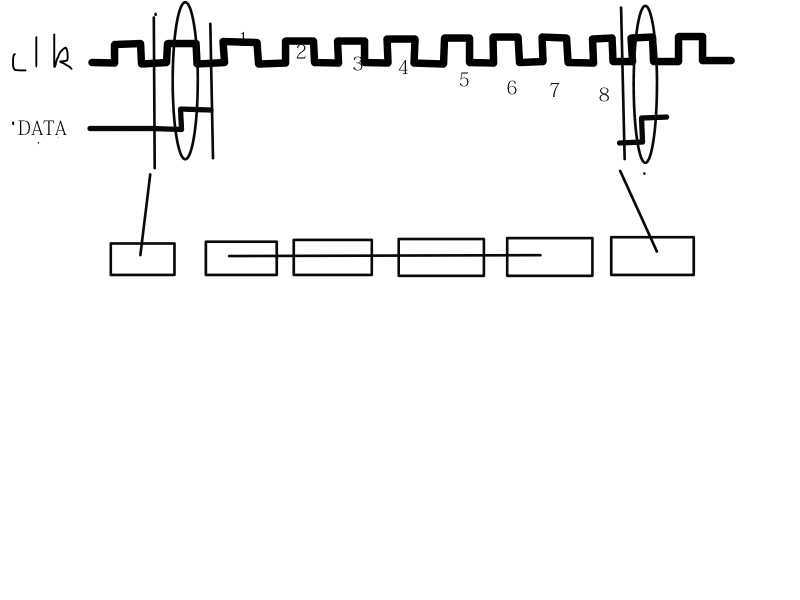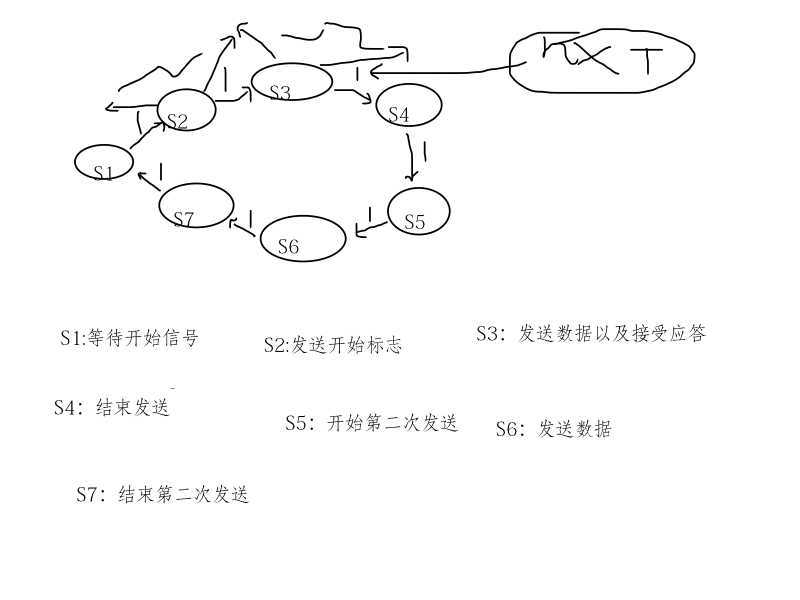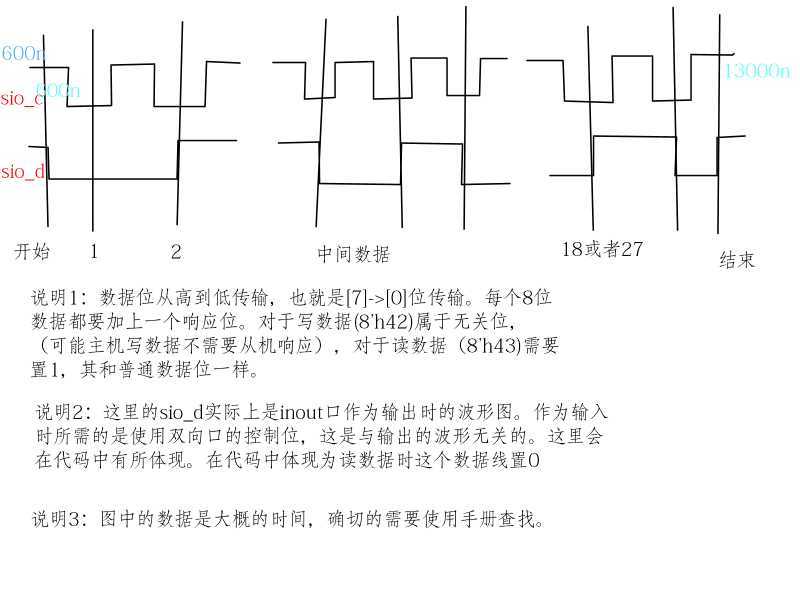SCCB协议常用于vo系列的摄像头的寄存器配置中,是有IIC协议演变而来。本来,本人接触这个协议也是想配置摄像头用于摄像模块。但是,由于配置寄存器实在是太多,而且需要找的资料也比较多,就放弃了,以后有时间再去完成吧。现在先将SCCB协议的设计过程记录下来,方便以后查找。
SCCB协议的内容和IIC协议的内容大致相似。有开始位、数据位和结束位。只不过开始位和结束位的形式还是有所不同的。当然,这里指的是双线的SCCB协议,至于三线的协议,只是了解过,感兴趣可以在网上查一下。

这里是一相数据的简图(图中应该有九个数据,由于前期理解不到位认为是八个)。可以看到除了开始位和结束位发生了“错位”,其他的类型和IIC基本一样。
在SCCB中,一次完整的传输不是以一相为单位的,而是两相或三相为单位的。两相是用于读取数据,而三相则是用于写入数据。
这是设计时画的状态机简图,还是比较简单的,七个状态单个循环就可以实现。具体的时间间隔在代码中有,可以从数据手册中可以找到最小值。这里不做过多的细节介绍。
同理,写操作还要比读简单,只需要一次三相操作即可。只需要将状态机的状态数减为4,将数据传输状态的有两相改为三相即可。这里在代码中会有具体的体现。
从前面的简介看还是比较简单的,但是细节还是比较多,下面给一张细节图供后续的设计。

前面提到了使用状态机实现,自然需要构建状态机。
module sccb_read ( input clk, input rst_n, input work, output work_end, input sio_din, output reg sio_dcr, output reg sio_c, output reg sio_dout, output reg [7:0] data_get ); localparam D3000=3000; localparam D1500=D3000/2; localparam Cnt_D1500=D1500/20; localparam Cnt_D3000=D3000/20; localparam T54000n=Cnt_D3000*19; localparam T15000n=Cnt_D3000*10; localparam S1=4‘d0; localparam S2=4‘d1; localparam S3=4‘d2; localparam S4=4‘d3; localparam S5=4‘d4; localparam S6=4‘d5; localparam S7=4‘d6; wire [8:0] id; wire [8:0] ad; wire [8:0] id2; assign id={8‘h42,1‘b0}; assign ad={8‘h03,1‘b0}; assign id2={8‘h43,1‘b0}; reg [3:0] state_now; reg [3:0] state_nxt; reg [7:0] cnt_wait; reg [7:0] cnt_start; reg [11:0] cnt_data; reg [11:0] cnt_stop; reg [7:0] cnt_start2; reg [11:0] cnt_data2; reg [11:0] cnt_stop2; reg [4:0] cnt_site; reg [7:0] cnt_clk; always@(posedge clk or negedge rst_n)begin if(!rst_n)begin state_now<=S1; end else begin case(state_now) S1: if(work && cnt_wait==Cnt_D3000-1‘b1)state_now<=state_nxt; S2: if(cnt_start==Cnt_D3000-1‘b1)state_now<=state_nxt; S3: if(cnt_data==T54000n-1‘b1)state_now<=state_nxt; S4: if(cnt_stop==T15000n-1‘b1)state_now<=state_nxt; S5: if(cnt_start2==Cnt_D3000-1‘b1)state_now<=state_nxt; S6: if(cnt_data2==T54000n-1‘b1)state_now<=state_nxt; S7: if(cnt_stop2==T15000n-1‘b1)state_now<=state_nxt; endcase end end always@(*)begin case(state_now) S1: state_nxt<=S2; S2: state_nxt<=S3; S3: state_nxt<=S4; S4: state_nxt<=S5; S5: state_nxt<=S6; S6: state_nxt<=S7; S7: state_nxt<=S1; endcase end always@(posedge clk or negedge rst_n)begin if(!rst_n)begin cnt_wait<=1‘b0; end else if(cnt_wait==Cnt_D3000)begin cnt_wait<=1‘b0; end else if(state_now==S1 )begin if(work)begin cnt_wait<=cnt_wait+1‘b1; end end else begin cnt_wait<=1‘b0; end end always@(posedge clk or negedge rst_n)begin if(!rst_n)begin cnt_start<=1‘b0; end else if(cnt_start==Cnt_D3000-1‘b1) begin cnt_start<=1‘b0; end else if(state_now==S2)begin cnt_start<=cnt_start+1‘b1; end else begin cnt_start<=1‘b0; end end always@(posedge clk or negedge rst_n)begin if(!rst_n)begin cnt_data<=1‘b0; end else if(cnt_data==T54000n -1‘b1)begin cnt_data<=1‘b0; end else if(state_now==S3 ) begin cnt_data<=cnt_data+1‘b1; end else begin cnt_data<=1‘b0; end end always@(posedge clk or negedge rst_n)begin if(!rst_n)begin cnt_stop<=1‘b0; end else if(cnt_stop==T15000n-1‘b1) begin cnt_stop<=1‘b0; end else if(state_now==S4)begin cnt_stop<=cnt_stop+1‘b1; end else begin cnt_stop<=1‘b0; end end always@(posedge clk or negedge rst_n)begin if(!rst_n)begin cnt_start2<=1‘b0; end else if(cnt_start2==Cnt_D3000-1‘b1) begin cnt_start2<=1‘b0; end else if(state_now==S5)begin cnt_start2<=cnt_start2+1‘b1; end else begin cnt_start2<=1‘b0; end end always@(posedge clk or negedge rst_n)begin if(!rst_n)begin cnt_data2<=1‘b0; end else if(cnt_data2==T54000n -1‘b1)begin cnt_data2<=1‘b0; end else if(state_now==S6 ) begin cnt_data2<=cnt_data2+1‘b1; end else begin cnt_data2<=1‘b0; end end always@(posedge clk or negedge rst_n)begin if(!rst_n)begin cnt_stop2<=1‘b0; end else if(cnt_stop2==T15000n-1‘b1) begin cnt_stop2<=1‘b0; end else if(state_now==S7)begin cnt_stop2<=cnt_stop2+1‘b1; end else begin cnt_stop2<=1‘b0; end end
这里是状态机的主体部分和驱动部分。由于这个协议的时间是有具体的要求,所以这里所有的状态转化都是基于特定的时间长度来构建的,而不是采用控制方式。除了第一个状态是需要外部驱动,其他的状态都是可以基于时间自行运转的,这也简化了后续的仿真时的难度。那个部分的状态不对可以直接对应到时间上,而不是去判断多个判断信号。本人认为这段代码还是比较基础的,就没有加上注释。
always@(posedge clk or negedge rst_n)begin if(!rst_n)begin cnt_clk<=1‘b0; end else if(cnt_clk==Cnt_D1500-1‘b1)begin cnt_clk<=1‘b0; end else if(state_now==S3 || state_now== S6) begin cnt_clk<=cnt_clk+1‘b1; end else begin cnt_clk<=1‘b0; end end always@(posedge clk or negedge rst_n)begin if(!rst_n)begin sio_c<=1‘b1; end else begin case(state_now) S1:sio_c<=1‘b1; S2:sio_c<=1‘b1; S3:if(cnt_clk==Cnt_D1500-1‘b1)sio_c=~sio_c; S4:sio_c<=1‘b1; S5:sio_c<=1‘b1; S6:if(cnt_clk==Cnt_D1500-1‘b1)sio_c=~sio_c; S7:sio_c<=1‘b1; endcase end end always@(posedge clk or negedge rst_n)begin if(!rst_n)begin cnt_site<=1‘b0; end else if(state_now==S3 || state_now==S6) begin if(cnt_clk==Cnt_D1500/2-1‘b1 && sio_c==1‘b0 )begin cnt_site<=cnt_site+1‘b1; end else begin cnt_site<=cnt_site; end end else begin cnt_site<=1‘b0; end end always@(posedge clk or negedge rst_n)begin if(!rst_n)begin sio_dout<=1‘b1; end else begin case(state_now) S1:sio_dout<=1‘b1; S2:if(cnt_start==Cnt_D1500-1‘b1)sio_dout<=1‘b0; S3:begin case(cnt_site) 5‘d0:sio_dout<=sio_dout; 5‘d1:sio_dout<=id[8]; 5‘d2:sio_dout<=id[7]; 5‘d3:sio_dout<=id[6]; 5‘d4:sio_dout<=id[5]; 5‘d5:sio_dout<=id[4]; 5‘d6:sio_dout<=id[3]; 5‘d7:sio_dout<=id[2]; 5‘d8:sio_dout<=id[1]; 5‘d9:sio_dout<=id[0]; 5‘d10:sio_dout<=ad[8]; 5‘d11:sio_dout<=ad[7]; 5‘d12:sio_dout<=ad[6]; 5‘d13:sio_dout<=ad[5]; 5‘d14:sio_dout<=ad[4]; 5‘d15:sio_dout<=ad[3]; 5‘d16:sio_dout<=ad[2]; 5‘d17:sio_dout<=ad[1]; 5‘d18:sio_dout<=ad[0]; 5‘d19:sio_dout<=1‘b0; default:sio_dout<=sio_dout; endcase end S4:if(cnt_stop==Cnt_D1500-1‘b1)sio_dout<=1‘b1; S5:if(cnt_start2==Cnt_D1500-1‘b1)sio_dout<=1‘b0; S6:begin case(cnt_site) 5‘d0:sio_dout<=sio_dout; 5‘d1:sio_dout<=id2[8]; 5‘d2:sio_dout<=id2[7]; 5‘d3:sio_dout<=id2[6]; 5‘d4:sio_dout<=id2[5]; 5‘d5:sio_dout<=id2[4]; 5‘d6:sio_dout<=id2[3]; 5‘d7:sio_dout<=id2[2]; 5‘d8:sio_dout<=id2[1]; 5‘d9:sio_dout<=id2[0]; 5‘d18:sio_dout<=1‘b1; 5‘d19:sio_dout<=1‘b0; default:sio_dout<=sio_dout; endcase end S7:if(cnt_stop2==Cnt_D1500-1‘b1)sio_dout<=1‘b1; endcase end end always@(posedge clk or negedge rst_n)begin if(!rst_n)begin sio_dcr<=1‘b1; end else begin case(state_now) S1:sio_dcr<=1‘b1; S2,S3,S4,S5,S7:sio_dcr<=1‘b1; S6:if(5‘d9<cnt_site && cnt_site<5‘d18)sio_dcr<=1‘b0;else sio_dcr<=1‘b1; endcase end end always@(posedge clk or negedge rst_n)begin if(!rst_n)begin data_get<=8‘b1111_1111; end else if(state_now==S6 && cnt_clk==Cnt_D1500/2-1‘b1 && sio_c==1‘b1 ) begin case(cnt_site) 5‘d10: data_get[7]<=sio_din; 5‘d11: data_get[6]<=sio_din; 5‘d12: data_get[5]<=sio_din; 5‘d13: data_get[4]<=sio_din; 5‘d14: data_get[3]<=sio_din; 5‘d15: data_get[2]<=sio_din; 5‘d16: data_get[1]<=sio_din; 5‘d17: data_get[0]<=sio_din; endcase end end assign work_end=(state_now==S7 && cnt_stop2==T15000n-1‘b1); endmodule
这段代码则是有了状态机的基础上,针对所需的输出,构建的输出模型。具体的比较复杂,我也记不大清楚细节。大致看一下,最好自己写。这是SCCB实现的关键逻辑。
至于写模块就是这个模块的删减和增加,直接上代码即可:
module sccb_write ( input clk, input rst_n, input work, input [15:0] data_sum, output work_end, // input sio_din, output reg sio_dcr, output reg sio_c, output reg sio_dout ); localparam D3000=3000; localparam D1500=D3000/2; localparam Cnt_D1500=D1500/20; localparam Cnt_D3000=D3000/20; localparam T81000n=Cnt_D3000*28; localparam T15000n=Cnt_D3000*10; localparam S1=4‘d0; localparam S2=4‘d1; localparam S3=4‘d2; localparam S4=4‘d3; wire [8:0] id; wire [8:0] ad; wire [8:0] da; assign id={8‘h42,1‘b0}; assign ad={data_sum[15:8],1‘b0}; assign da={data_sum[7:0],1‘b0}; reg [1:0] state_now; reg [1:0] state_nxt; reg [7:0] cnt_wait; reg [7:0] cnt_start; reg [14:0] cnt_data; reg [11:0] cnt_stop; reg [4:0] cnt_site; reg [7:0] cnt_clk; always@(posedge clk or negedge rst_n)begin if(!rst_n)begin state_now<=S1; end else begin case(state_now) S1: if(work && cnt_wait==Cnt_D3000-1‘b1)state_now<=state_nxt; S2: if(cnt_start==Cnt_D3000-1‘b1)state_now<=state_nxt; S3: if(cnt_data==T81000n-1‘b1)state_now<=state_nxt; S4: if(cnt_stop==T15000n-1‘b1)state_now<=state_nxt; endcase end end always@(*)begin case(state_now) S1: state_nxt<=S2; S2: state_nxt<=S3; S3: state_nxt<=S4; S4: state_nxt<=S1; endcase end always@(posedge clk or negedge rst_n)begin if(!rst_n)begin cnt_wait<=1‘b0; end else if(cnt_wait==Cnt_D3000)begin cnt_wait<=1‘b0; end else if(state_now==S1 )begin if(work)begin cnt_wait<=cnt_wait+1‘b1; end end else begin cnt_wait<=1‘b0; end end always@(posedge clk or negedge rst_n)begin if(!rst_n)begin cnt_start<=1‘b0; end else if(cnt_start==Cnt_D3000-1‘b1) begin cnt_start<=1‘b0; end else if(state_now==S2)begin cnt_start<=cnt_start+1‘b1; end else begin cnt_start<=1‘b0; end end always@(posedge clk or negedge rst_n)begin if(!rst_n)begin cnt_data<=1‘b0; end else if(cnt_data==T81000n -1‘b1)begin cnt_data<=1‘b0; end else if(state_now==S3 ) begin cnt_data<=cnt_data+1‘b1; end else begin cnt_data<=1‘b0; end end always@(posedge clk or negedge rst_n)begin if(!rst_n)begin cnt_stop<=1‘b0; end else if(cnt_stop==T15000n-1‘b1) begin cnt_stop<=1‘b0; end else if(state_now==S4)begin cnt_stop<=cnt_stop+1‘b1; end else begin cnt_stop<=1‘b0; end end always@(posedge clk or negedge rst_n)begin if(!rst_n)begin cnt_clk<=1‘b0; end else if(cnt_clk==Cnt_D1500-1‘b1)begin cnt_clk<=1‘b0; end else if(state_now==S3 ) begin cnt_clk<=cnt_clk+1‘b1; end else begin cnt_clk<=1‘b0; end end always@(posedge clk or negedge rst_n)begin if(!rst_n)begin sio_c<=1‘b1; end else begin case(state_now) S1:sio_c<=1‘b1; S2:sio_c<=1‘b1; S3:if(cnt_clk==Cnt_D1500-1‘b1)sio_c=~sio_c; S4:sio_c<=1‘b1; endcase end end always@(posedge clk or negedge rst_n)begin if(!rst_n)begin cnt_site<=1‘b0; end else if(state_now==S3 ) begin if(cnt_clk==Cnt_D1500/2-1‘b1 && sio_c==1‘b0 )begin cnt_site<=cnt_site+1‘b1; end else begin cnt_site<=cnt_site; end end else begin cnt_site<=1‘b0; end end always@(posedge clk or negedge rst_n)begin if(!rst_n)begin sio_dout<=1‘b1; end else begin case(state_now) S1:sio_dout<=1‘b1; S2:if(cnt_start==Cnt_D1500-1‘b1)sio_dout<=1‘b0; S3:begin case(cnt_site) 5‘d0:sio_dout<=sio_dout; 5‘d1:sio_dout<=id[8]; 5‘d2:sio_dout<=id[7]; 5‘d3:sio_dout<=id[6]; 5‘d4:sio_dout<=id[5]; 5‘d5:sio_dout<=id[4]; 5‘d6:sio_dout<=id[3]; 5‘d7:sio_dout<=id[2]; 5‘d8:sio_dout<=id[1]; 5‘d9:sio_dout<=id[0]; 5‘d10:sio_dout<=ad[8]; 5‘d11:sio_dout<=ad[7]; 5‘d12:sio_dout<=ad[6]; 5‘d13:sio_dout<=ad[5]; 5‘d14:sio_dout<=ad[4]; 5‘d15:sio_dout<=ad[3]; 5‘d16:sio_dout<=ad[2]; 5‘d17:sio_dout<=ad[1]; 5‘d18:sio_dout<=ad[0]; 5‘d19:sio_dout<=da[8]; 5‘d20:sio_dout<=da[7]; 5‘d21:sio_dout<=da[6]; 5‘d22:sio_dout<=da[7]; 5‘d23:sio_dout<=da[4]; 5‘d24:sio_dout<=da[3]; 5‘d25:sio_dout<=da[2]; 5‘d26:sio_dout<=da[1]; 5‘d27:sio_dout<=da[0]; 5‘d28:sio_dout<=1‘b0; default:sio_dout<=sio_dout; endcase end S4:if(cnt_stop==Cnt_D1500-1‘b1)sio_dout<=1‘b1; endcase end end always@(posedge clk or negedge rst_n)begin if(!rst_n)begin sio_dcr<=1‘b0; end else if(work) begin sio_dcr<=1‘b1; end else begin sio_dcr<=1‘b1; end end assign work_end=(state_now==S4 && cnt_stop==T15000n-1‘b1); endmodule
实现的功能就是一次数据写入。
然后是顶层的模块:
module vo( input clk, input rst_n, inout sio_d, output sio_c, output pwdn, output reset, output xclk, output [7:0] data_get ); reg work_r; reg work_w; wire sio_din; wire work_end_r; wire work_end_w; wire sio_dcr; wire sio_dcr_r; wire sio_dcr_w; wire sio_dout; wire sio_dout_r; wire sio_dout_w; wire sio_c_r; wire sio_c_w; reg [15:0] data_sum; wire locked; assign sio_d = (sio_dcr) ? sio_dout : 1‘bz; assign sio_din = sio_d; assign sio_dout = sio_dout_r & sio_dout_w; assign sio_c = sio_c_r & sio_c_w; assign sio_dcr = sio_dcr_r & sio_dcr_w; assign pwdn=1‘b0; assign reset=1‘b1; reg [7:0] cnt_work; always@(posedge clk or negedge rst_n)begin if(!rst_n)begin cnt_work<=1‘b0; end else if(cnt_work==8‘d11)begin cnt_work<=8‘d11; end else if(cnt_work==8‘d10 && work_end_r)begin cnt_work<=8‘d11; end else if(work_end_w)begin cnt_work<=cnt_work+1‘b1; end end always@(posedge clk or negedge rst_n)begin if(!rst_n)begin work_w<=1‘b0; end else if(cnt_work<8‘d10 && locked) begin work_w<=1‘b1; end else begin work_w<=1‘b0; end end always@(posedge clk or negedge rst_n)begin if(!rst_n)begin work_r<=1‘b0; end else if(cnt_work==8‘d10 && locked)begin work_r<=1‘b1; end else begin work_r<=1‘b0; end end always@(posedge clk or negedge rst_n)begin if(!rst_n)begin data_sum<=16‘h1280; end else begin case(cnt_work) 8‘d0:data_sum<=16‘h1280; // reset sccb reg 8‘d1:data_sum<=16‘h1101; // raw data half clk 8‘d2:data_sum<=16‘h3a04; // 8‘d3:data_sum<=16‘h1201; // 8‘d4:data_sum<=16‘h1716; 8‘d5:data_sum<=16‘h1804; 8‘d6:data_sum<=16‘h1902; 8‘d7:data_sum<=16‘h1a7b; 8‘d8:data_sum<=16‘h3280; 8‘d9:data_sum<=16‘h0306; default:data_sum<=data_sum; endcase end end pll pll_1( .areset(~rst_n), .inclk0(clk), .c0(xclk), .locked(locked) ); sccb_write m1( .clk(clk), .rst_n(rst_n), .work(work_w), .data_sum(data_sum), .work_end(work_end_w), // input sio_din, .sio_dcr(sio_dcr_w), .sio_c(sio_c_w), .sio_dout(sio_dout_w) ); sccb_read m2( .clk(clk), .rst_n(rst_n), .work(work_r), .work_end(work_end_r), .sio_din(sio_din), .sio_dcr(sio_dcr_r), .sio_c(sio_c_r), .sio_dout(sio_dout_r), .data_get(data_get) );
本来顶层模块最好不要写逻辑,但是由于只是个人尝试,前期为了省事就在顶层里写了执行循环的模块。这就直接导致后期就不想移动代码。最后就成了这个样子。将就着用吧,本来就是用于测试一下的。
这个顶层的执行模块就是执行十次写数据和一次读数据。值得注意的是关于双向口的编写。这也是在前面读数据模块中会有sio_din,sio_dout,sio_dcr三个输入输出。这是用于模仿三态门。
由于篇幅有限,仿真文件就不附上了。关于inout的仿真这里简单的说一下。
要在激励文件中设计inout,就要明白对应关系。使用同样的方法将inout转化为一个input、一个output和一个控制位。在这里如果想要完全模拟SCCB的从机,需要使用复杂的逻辑来判断读取和写入的状态。但是,如果只是想要简单地了解自己的设计是否成功,只需要将其强制为接受状态就行。
结果的话就展示一下modelsim的仿真图。

这部分是读的时序逻辑。

这部分是写的逻辑,由于修改模块输入后没有修改激励的输出,所以地址位和数据位是没有值的。

这是顶层模块的结果图。
在实际的板级测试时,数据基本上写读一致。由于只是测试了几个寄存器,也不确定是不是所有的都可行,这里就到此为止了。以后有时间可以应用到摄像头上。
原文:https://www.cnblogs.com/electricdream/p/13027348.html